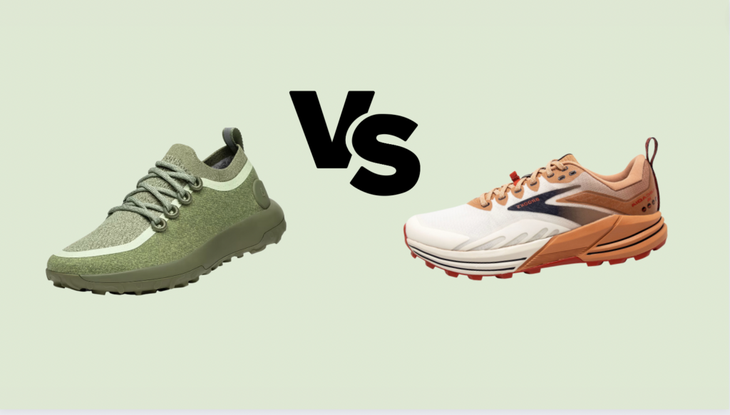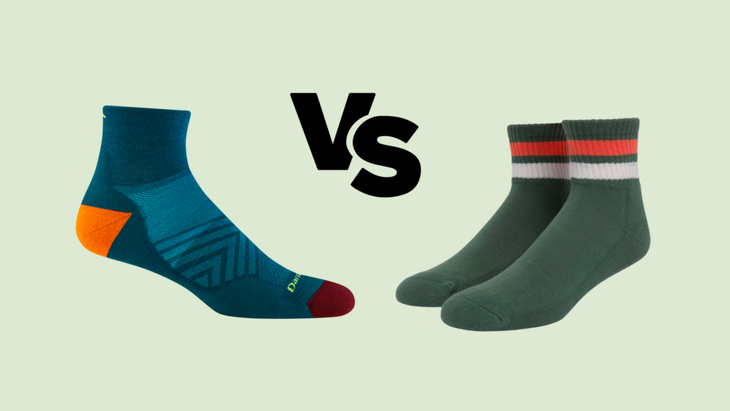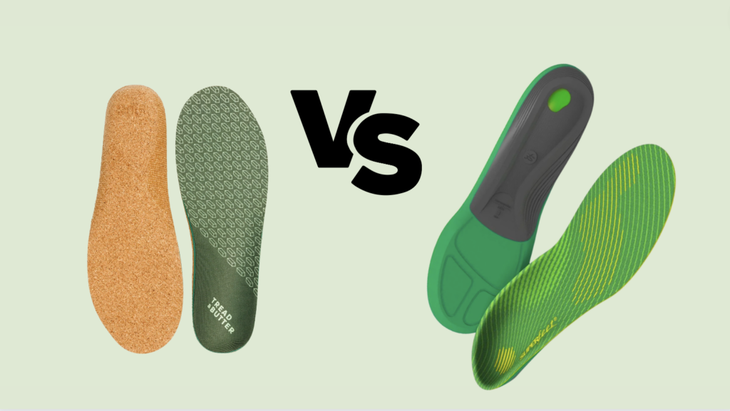Can “Eco-Friendly” Running Gear Also Be Durable?
This article originally appeared on Outside
Runners are known for putting their gear through the wringer, pushing items like shoes, socks, and clothing to their limits. Thus, durability can often be a main factor driving runners' consumer behavior. A current trend across the outdoor industry is investing in gear that uses sustainable manufacturing alternatives and eco-friendly recycled materials to create a greener industry. But it's here, at this intersection of durability and eco-conscious production, where tests have shown that recycled products are taking a hit in the durability category, often turning out to be less "sustainable" than manufacturers intend because of how quickly they have to be thrown away. How do we, as runners, navigate this?
Longevity Versus Recyclability
In order to support truly green trail running gear, some manufacturers have begun to focus on longevity in conjunction with recyclability. Because, while recycling is used as a strategy to reduce the industry's carbon footprint and keep materials out of the landfill, recycled materials aren't always necessarily made to last and, therefore, aren't sustainable. As with most everything, it's complicated.
"It is proven that longevity is a crucial factor within circularity. Keeping durable products in use for longer helps reduce the environmental footprint caused by new production," says Martina Lux-Arenza, global footwear strategic marketer for GORE-TEX.
While 100 percent recycled products often underperform in durability compared to their virgin counterparts, one way to change this reality is by using material blends. "OrthoLite insoles contain a range of recycled content, from 5 percent up to 98 percent," says CB Tuite, chief sales officer for OrthoLite, a company that produces high-performance running insoles. "Reusing post-production waste is part of our 'secret sauce' With our recycled formulations, our head chemist has found a way to effectively blend both virgin and recycled chemistry to deliver the highest-performing sock liner technologies."
The main drawback with this strategy is that some blended materials are much harder to recycle, which therefore causes disruptions to true sustainability downstream.
The Costs of Eco-Friendly Production
If you go to your favorite running brand's website and compare the cost of a recycled pair of socks or shoes with virgin ones, you'll notice that there isn't much of a price difference.
Often it costs manufacturers more to create recycled products than virgin products, so many of them are taking a hit on profits to create greener alternatives. Recycling is extremely labor and energy intensive. Recycled materials have to be cleaned, shredded and melted. Virgin materials, on the other hand, skip a few of these steps, making them more affordable to make.
"Variability of raw [recycled] materials vary to a greater degree when compared to virgin material. This requires more testing and also requires us to build in some additional buffers to compensate for possible variability of such raw materials. This additional effort in quality control increases the cost of making the products, but we strongly believe there is value to include this in our product strategy," says Lux-Arenz.
"The demand is increasing for recycled raw materials, so the supply is still lagging which can cause modest pricing differences," says Alex Lauver, senior director of Materials Innovation and Sustainability for Outdoor Research. "When creating a new product, this small difference is easier to mitigate but established, legacy collections sometimes see a bit of a cost increase that needs to be offset. We either take a bit less margin or we have to slightly increase the retail [cost]."

What's more is that many brands assume the risk of adopting recycled products. Brands like GORE-TEX apply their "guaranteed to keep you dry" promise, even their recycled running jackets, meaning that the consumer doesn't assume the financial risk of supporting recycled products.
To better understand the relationship between eco-friendly and durability, we put three product categories--shoes, socks, and insoles--head to head to see how they differ.
Shoes, Socks, and Insoles
SHOES: AllBirds Trail Runner SWT Versus Brooks Divide 3 Trail Runner

Running shoes are one of the biggest contributors to carbon emissions in the outdoor space. The typical pair of running shoes produces 14 kg of carbon emissions from its inception to the end of its life. The manufacturing process is the largest contributor to this figure. (Comparatively, the standard pair of socks produces 4 kg of CO2.)
While brands like Brooks have been able to reduce that figure by nearly 5 percent, by turning to bio-based solutions, there's still a significant problem; most recycled running shoes still end up in the landfill because they are manufactured in a way that makes it impractical to recycle them.
Brands like AllBirds take things a step further by manufacturing carbon-neutral products that offer a consistently high performance. And since AllBird shoes are made with merino wool, eucalyptus, and sugar cane, it's easier to break the shoe down after it's reached the end of its life. They also intend to double the lifespan of their shoes by 2025, reducing the need for further production. While attempting to reduce overall production isn't exactly the most intuitive business model, it does seem to support sustainable running solutions.
The Trail Runner SWT is one of AllBirds' most durable shoes, and it manages to achieve a lifespan of 8-10 months of moderate use depending on the number of miles athletes put on them. The Brooks Divide 3, while not specifically known for its sustainable properties, takes a classic shoe and allows runners to get about 500 miles out of it, leaving us with a potentially longer-lasting shoe. The price point of the AllBirds Trail Runner is slightly higher than the Divide, too, costing $140 instead of $100. But it doesn't lack in quality or integrity that would contribute to premature deterioration. Due to their carbon-neutral practices and simple material construction, the AllBirds Trail Runner SWT has a slight edge over the Brooks Divide 3 when it comes to sustainability.
SOCKS: Darn Tough Quarter Ultra-Lightweight Running Sock Versus Girlfriend Quarter Crew

Darn Tough socks are famous for their lifetime guarantee; they're arguably the most durable sock option on the market. With sustainably sourced wool, these socks can last for thousands of miles. But since they utilize a blend of wool, nylon, and lyrica, they can be somewhat difficult to recycle.
Comparatively, the Girlfriend Quarter Crew Sock is made out of plastic bottles and a small amount of spandex. Pricewise, the virgin fiber Darn Tough socks are slightly more expensive than the Girlfriend socks, costing $19 per pair as opposed to $14. They can also be swapped out for a new pair at no cost to the consumer. And they will likely outlast the Girlfriend socks in a high-performance environment.
While materials like wool are highly recyclable on their own, it becomes more impractical to recycle those materials when they're blended with something like polyester, unless they are repurposed or upcycled for things like cushion filling. Both Darn Tough and Girlfriend socks use blends, so the difference boils down to longevity and cost, even if the marketing campaigns claim that their socks use "highly recyclable materials," which makes Darn Toughs a top contender.
INSOLES: Tread & Butter Versus Superfeet Run Comfort

Tread & Butter is a climate-neutral certified brand that's best known for its cork running insoles. The brand's insoles are made in Portugal at a plant that uses cork dust to partially run the plant. These insoles, though lesser known among runners, are both built for performance and marketed to the sustainably-conscious, eco-friendly consumer. Compared to petroleum-based plastics and EVA, cork is far less energy intensive. But as a lightweight material, these insoles could wear faster than plastic alternatives.
Comparatively, Superfeet Run Comfort Insoles come with durable components like a carbon fiber cap. They also have a lifespan of about a year, depending on the level of activity. Since the average insoles last anywhere from 6 months to a year, Superfeet's Run Comfort Insoles do a good job of pushing the limits of durability.
Tread & Butter Insoles cost $39.95 to $49.95 while the Superfeet Run Comfort Insoles cost $54.99. Tread & Butter insoles are likely easier to recycle, but Superfeet's Run Comfort Insoles may take the take when it comes to longevity.
The Bottom Line:
Most consumers are willing to shell out a bit of extra cash for a plant-friendly, eco-friendly product, but even we have limits. Studies show that when a product cost becomes 20 percent higher than the industry standard's cost, only about 4 percent of consumers will opt for the recycled option.
In the end, labeling gear as "sustainable" suggests that manufacturer's have made it to the end of the road, and greenwashing is too often used to motivate buyers to invest in a specific product. Without having access to a brand's transparent manufacturing and recycling processes, it can be difficult to determine whether or not recycled gear is truly sustainable.
"Consider second use or donating your shoes rather than throwing them away," says Lux-Arenz. "Try to maximize the longevity and durability of your shoes through regular wash and care in order to minimize the carbon and environmental footprint."
For exclusive access to all of our fitness, gear, adventure, and travel stories, plus discounts on trips, events, and gear, sign up for Outside+ today.

